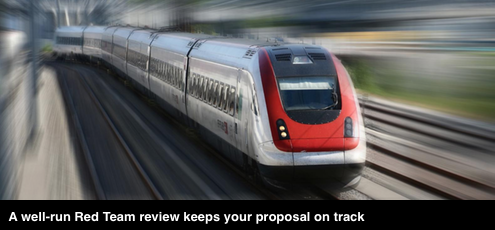This is part of a series on how to manage large proposal narratives to submission. Recent posts focused on preparing proposal writers for success and pre-Red Team management. This entry provides guidance on running a Red Team review session.
Red Team review input
As advised in last week’s post, send all participants the annotated sections in MS Word or PDF format at least two days before the review. Include a clear expectation that reviewers read and be familiar with the content prior to the review.
Review process
Use the following steps as a starting point and modify to suit your situation:
- Welcome participants and thank them for their efforts to date. Confirm everyone has received the content
- Remind everyone of the status of the narratives—leaders have reviewed content against RFP and strategy to identify gaps or confusing content that will not score well and visualization opportunities for discussion during review
- Establish the order of sections. Start with big picture sections as a warm-up, but then move to any particularly complex or problematic sections to take advantage of morning energy, scheduling less challenging sections for after lunch
- Remind everyone of the purpose: To ensure responses answer the questions and identify opportunities to improve clarity, responsiveness and competitive positioning. Red Team is not a forum for copy tweaking
- Set ground rules: No slowing down for people who haven’t read sections; session leader will suggest taking discussions offline after 4-5 minutes; content leads should understand and agree with all decisions and commitments made
- Explain work that will be done after the review. Assure participants that all content will be edited for grammar, consistency and one voice to achieve a finished product
- Begin review, making sure all commitments are recorded and annotations understood by those responsible
- Break after 75-90 minutes to assess progress
Technology
Project the current section in MS Word and live edit the annotations, so all attendees can follow and see the results of their input and evidence of assignments and commitments made.
Consider using a second screen on which you can keep the RFP, org chart, ATOC open for easy access.
Unified or multi-part reviews?
We’re often asked whether everyone needs to be present for all sections. Is it not more efficient to conduct a review with just the author(s) for each individual section? The answer depends on the situation. Use the following for guidance in deciding:
- RFQ responses, which are fairly short and aim to present a unified team and strategy, are best reviewed by the entire team to ensure no opportunities for fresh thinking, cross-section references and strategic consistency are missed
- Conversely, very large consortium RFP responses are almost always reviewed in rolling reviews, due to the volume of material to cover, the number of authors, and the time it takes to annotate and prepare content for review
- Single-company RFP responses, where everyone is familiar with the solution and have developed several proposals together, are also candidates for multi-part reviews
- Generally, the more one section’s content directly affects other sections, the stronger is the case for reviewing them together; also unified reviews offer the greatest opportunities for fresh thinking, and avoiding group think—assuming participants are fully engaged
Always do a Red Team review
Do not skip the Red Team review step in developing proposals. With proper preparation and management, this review allows you to make major course corrections and improvements while there is still time before submission.


